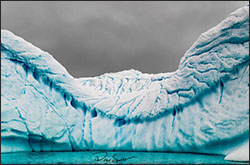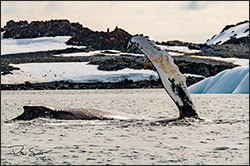Climate Change and the Polar Regions: Teacher Resources and Research
The Polar areas of the Earth are the fastest warming regions on the planet. As a result, the poles are an ideal environment for studying climate change and its impacts on local and global ecosystems. The resources on this site, with special emphasis on Antarctica, are intended to assist teachers, their students, and their communities to learn more about climate using real-time research conducted at Palmer Station, Antarctica.
 An Adelie penguin feeding her chicks. Photo by Drew Spacht |
 The hues of a melting iceberg. Photo by Drew Spacht |
 A humpback whale swimming. Photo by Drew Spacht |
Resources for Teachers
- Climate Change and the Polar Regions: Using teacher data from the 2016 Climate Change Teacher Academy, we have compiled some educational resources to help bring the polar regions and climate change into your science instruction. Find videos, websites, and lesson plans, for students of all ages.
- Comparing the Polar Regions: Using teacher data from the 2016 Climate Change Teacher Academy, we have compiled educational resources to help introduce students to the similarities and differences of the polar regions.
- Integrating Climate Change Across the Curriculum: Using teacher data from the 2016 Climate Change Teacher Academy, we have compiled some educational resources to help integrate climate change and the polar regions across the curriculum, including science, art, history, and social studies.
- 2017 Antarctic Research Expedition Blog: Follow Natalie, a MadeClear team member, as she chronicles her experiences working as a researcher at Palmer Station, Antarctica. Travel with her by icebreaker ship and learn about cutting-edge polar research at the coldest, windiest, driest region on the planet.
- An Introduction to the Poles (PDF) and Part Two: A Fly on the Pole (large PDF): Part I provides a comparison of the polar regions. Part II describes an Antarctic research team's experiences at Palmer Station. Both presentations highlight the effects of climate change in the polar regions, especially Antarctica.
Videos from Palmer Station, Antarctica
|
Dr. Paty Matrai, Senior Research Scientist at Bigelow Laboratory for Ocean Sciences, describes her marine research in the polar regions (Arctic and Antarctic) and its relation to climate change. (4 min) |
Dr. Ducklow, Columbia University, describes the long term research being conducted via an icebreaker ship at Palmer Station, Antarctica. He describes evidence of climate change in the region. (4 min) |
Natalie Ylizarde, a doctoral student in science education studying climate change education, conducts a live video teleconference for a classroom from Palmer Station, Antarctica. (4 min) |
These resources were made possible through the synergistic work of two NSF funded research projects (Principal Investigator Dr. J. Randy McGinnis NSF DUE 1043262 and Principal Investigator Dr. Richard E. Lee, Jr NSF PLR 1341385; NSF PLR 1341393).






